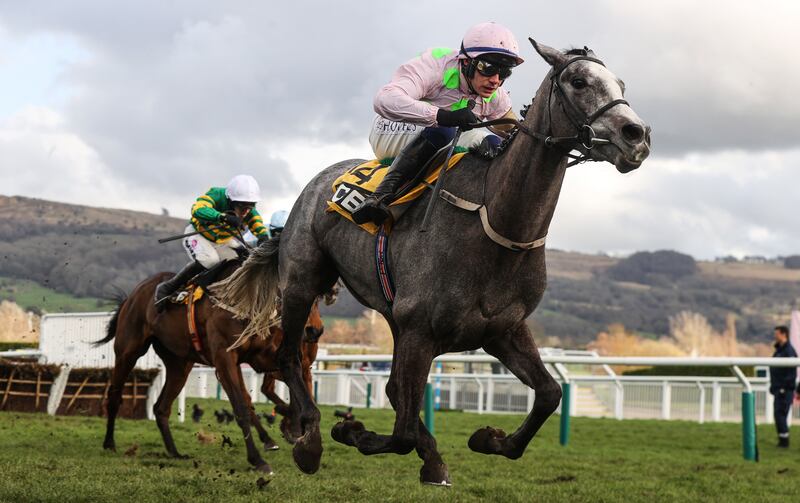If pop has long since eaten itself, it’s no stretch to suspect Cheltenham will find itself whistling a similar tune if some bum festival notes don’t get fixed quickly. Lots of voices have skin in the game of making out it’s going to be business as usual next week. Believing the hype is tough, however, when anticipation levels appear less Hi-Ho and more Ho-Hum.
The machine is teeing it up with those same riffs about Cheltenham being jump racing’s Olympics, and an ultimate championship test of man and beast, that have underpinned the festival’s appeal for generations. They used to more than hold water too. But there’s a rote vibe to much of it these days that just sounds more and more off-key, like a smash hit played to death.
The original ‘eat itself’ line referenced industry’s instinct for repackaging. Jump racing’s greatest shop window has been rejigged, recycled, and rebranded into a competitive curate’s egg. Bits of next week promise to be genuinely enthralling. Galopin Des Champs in the 100th Gold Cup is a mouth-watering prospect. But too much of the rest fails to live up to its championship billing.
Cheltenham is reaping the wind of the Jockey Club’s decision to milk the festival’s commercial value for all it is worth.
Kyprios starts down road to potential Arc tilt when returning to action at Navan
Willie Mullins set to overhaul Dan Skelton for British trainers’ title on final day of season
Fighting on two fronts no problem to Willie Mullins as he continues to make racing history
Welsh dragon roars at Fairyhouse as Haiti Couleurs lands Irish Grand National
It isn’t just nostalgia to recall fondly the tightly-structured three-day programme that mostly achieved what is supposed to be the ultimate point of the festival, clashes of the very best. Introducing a fourth day almost two decades ago, and the programme expansion necessary to pull it off, has produced a sprawling scenario that spreads things much too thin for Cheltenham’s good.
Ultimately, the festival is turning into a victim of its own success.
The result is a bloated programme stuffed with too many choices for a necessarily limited cast-list. Consequently, there are opportunities for horses to get slalomed around the various options in pursuit of the easiest winning chance. With all its history and prestige, festival success has become an end itself, no matter the context.
Nothing underlines how Cheltenham is effectively self-sabotaging its own prestige than the situation surrounding a star performer like Lossiemouth. Maybe she will ultimately end up in Tuesday’s Champion Hurdle. But the fact there’s even a doubt about it, never mind rampant uncertainty, underlines how systemic flaws are cutting the ground out from the festival’s popular appeal.

Lossiemouth is a proven festival winner with a glorious championship opportunity presented to her by Constitution Hill’s absence, and a potentially decisive 7lb sex allowance in her favour into the bargain. But logic demands why Willie Mullins should put her in a clash with his odds-on favourite State Man when there is a Grade One alternative in the Mares Hurdle just 40 minutes later.
It makes perfect sense from Mullins’s point of view. He is doing his job by trying to maximise the chances of winning as many races as possible. But strategic astuteness is no spectacle, nor does it prevent much of the run-up to this festival from being a weary exercise in trying to predict how a single dominant figure will most effectively divvy up his forces.
The position Mullins has put himself him in over the last decade, and on the verge of a once scarcely imaginable ‘century’ of festival winners, is testament to how he has exploited the new Cheltenham reality to devastating effect. By any standards his transformation of the sport is a remarkable achievement. It has also underpinned unprecedented dominance for this amorphous ‘Team Ireland.’
But rarely can a festival build-up have seemed so lethargic as this one. The prospect of more odds-on favourites than ever before, overwhelming dominance by one camp, and the hopelessly lopsided reality of the old Anglo-Irish rivalry, means there is plenty of evidence of flagging public interest. Sporting appeal can always fluctuate. But apathy is a tough opponent once it rears its head.
That last year, the idea was seriously floated about stretching things to a fifth day suggests the Jockey Club is playing serious catch-up with the public when it comes to valuing its greatest asset. Since Cheltenham is the sport’s greatest shop window, racing as a whole, and on both sides of the Irish Sea, has a major stake in rejuvenating the festival’s flagging competitive appeal.
Crucial to that must be recognition that sometimes less is more. Blaming individual owners and trainers for playing the programme in front of them to their own best advantage is a cop-out. Steps must be taken to encourage competition rather than dilute it. It’s time to hear something new rather than continue to rehash old hits that increasingly sound their age.
Something for the Weekend
The minimum trip on heavy ground looks just the ticket for WHISKEYWEALTH (3.55) in Gowran’s featured handicap chase on Saturday. Terence O’Brien’s runner won nicely over flights at Naas a month ago, after which the Co. Cork trainer pointed immediately towards this race. Jockey John Shinnick rode at Naas and again takes off a valuable 7lb.
Brian Acheson’s Robcour colours were successful in Saturday’s Gowran bumper with Bob Olinger (2020) and Journey With Me a year later. The businessman has bought December’s impressive Dromahane point-to-point winner GOOD N’KIND (5.40) who has a first start for Henry De Bromhead. This race has a history of throwing up significant talent – including Tullyhill a year ago – and this renewal looks like it will be no exception.


















